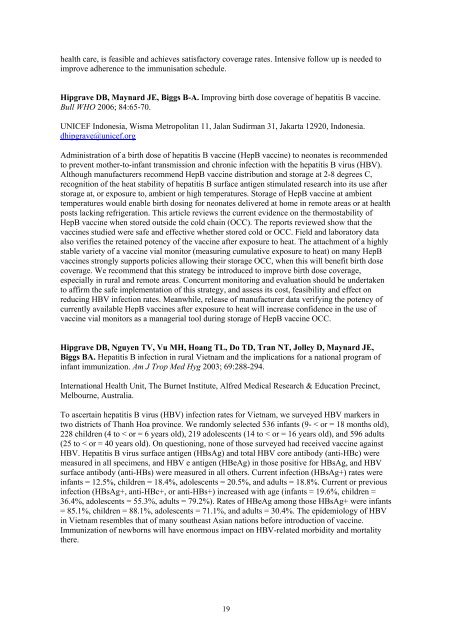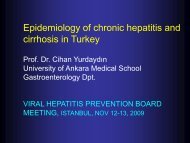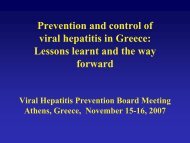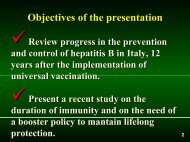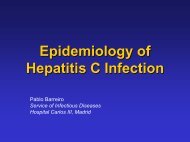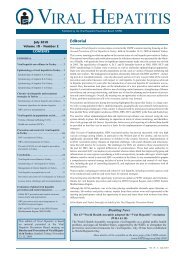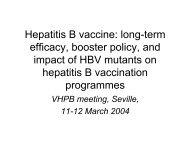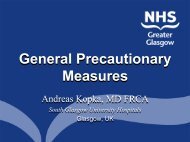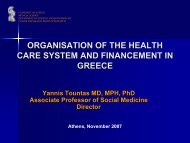to 14 years at the beg<strong>in</strong>n<strong>in</strong>g <strong>of</strong> HBV immunization was 18.59 to 20.52/100,000, <strong>and</strong> decl<strong>in</strong>ed to0.39 to 2.38/100,000 <strong>in</strong> 2000 (chi 2 = 58.26, P < 0.01). The HBsAg carry<strong>in</strong>g rate <strong>of</strong> the childrendecreased from 2.82% to 0.60%, about 80.00% after vacc<strong>in</strong>ation (chi 2 = 10.75, P < 0.01). HepatitisB vacc<strong>in</strong>ation <strong>of</strong> newborn babies is an effective measure for prevention <strong>and</strong> <strong>control</strong> <strong>of</strong> <strong>hepatitis</strong> B<strong>virus</strong> <strong>in</strong>fection.Grosheide PM, den Ouden AL, Verrips GH, Conyn-van Spaendonck MA, Loeber JG,Verloove-Vanhorick SP. Evaluation <strong>of</strong> the <strong>hepatitis</strong> B prevention program <strong>in</strong> newborn <strong>in</strong>fants. I.National data, 1990. Ned Tijdschr Geneeskd 1993; 137:2589-2594. [Article <strong>in</strong> Dutch]Centrum voor Infectieziekten Epidemiologie, Rijks<strong>in</strong>stituut voor Volksgezondheid enMilieuhygiene, Bilthoven.The aim was to evaluate the effectiveness <strong>of</strong> the national programme for prevention <strong>of</strong> <strong>per<strong>in</strong>atal</strong><strong>hepatitis</strong> B <strong>in</strong>fections. Sett<strong>in</strong>g: the regional public health laboratories <strong>and</strong> prov<strong>in</strong>cial immunizationadm<strong>in</strong>istrations <strong>in</strong> the Netherl<strong>and</strong>s. Design: retrospective evaluation. Start<strong>in</strong>g October 1989 rout<strong>in</strong>escreen<strong>in</strong>g <strong>of</strong> pregnant women for HBsAg was performed <strong>and</strong> passive-active immunisation <strong>of</strong><strong>in</strong>fants <strong>of</strong> HBsAg-positive mothers was added to the national immunisation programme. Infantsreceive <strong>hepatitis</strong> B immunoglobul<strong>in</strong> at birth <strong>and</strong> <strong>hepatitis</strong> B vacc<strong>in</strong>e at 3,4,5, <strong>and</strong> 11 months <strong>of</strong> age,concomitant with the DTP-polio vacc<strong>in</strong>e. The effectiveness <strong>of</strong> screen<strong>in</strong>g <strong>and</strong> <strong>in</strong>tervention <strong>in</strong> 1990was evaluated. Screen<strong>in</strong>g covered about 85% <strong>of</strong> the pregnant population <strong>and</strong> the prevalence(0.44%) was less than expected. About 60% <strong>of</strong> the <strong>in</strong>fants born to HBsAg-positive mothers wereregistered for vacc<strong>in</strong>ation. Of these <strong>in</strong>fants the average coverage was 83% for immunoglobul<strong>in</strong>,<strong>and</strong> 90%, 86%, 80% <strong>and</strong> 55% for the four successive <strong>hepatitis</strong> B vacc<strong>in</strong>ations. There wasconsiderable delay <strong>in</strong> vacc<strong>in</strong>e adm<strong>in</strong>istration; frequently doses were adm<strong>in</strong>istered later thanrecommended. Compliance with screen<strong>in</strong>g <strong>and</strong> vacc<strong>in</strong>ation appeared <strong>in</strong>complete.Recommendations for the simplification <strong>of</strong> the current programme are made.Grosheide PM, Klokman-Houwel<strong>in</strong>g JM, Conyn-van Spaendonck MA. Programme forprevent<strong>in</strong>g <strong>per<strong>in</strong>atal</strong> <strong>hepatitis</strong> B <strong>in</strong>fection through screen<strong>in</strong>g <strong>of</strong> pregnant women <strong>and</strong> immunisation<strong>of</strong> <strong>in</strong>fants <strong>of</strong> <strong>in</strong>fected mothers <strong>in</strong> The Netherl<strong>and</strong>s, 1989-92. National Hepatitis B Steer<strong>in</strong>gCommittee. BMJ 1995; 311:1200-1202.Department <strong>of</strong> Infectious Diseases Epidemiology, National Institute <strong>of</strong> Public Health <strong>and</strong>Environmental Protection, Bilthoven, Netherl<strong>and</strong>s.The objective was to launch a programme for the prevention <strong>of</strong> <strong>per<strong>in</strong>atal</strong> <strong>in</strong>fection with <strong>hepatitis</strong> B<strong>in</strong> the Netherl<strong>and</strong>s. Design: Rout<strong>in</strong>e antenatal screen<strong>in</strong>g <strong>and</strong> <strong>in</strong>tervention programme. Sett<strong>in</strong>g:community antenatal programme, the Netherl<strong>and</strong>s. Subjects: <strong>in</strong>fants <strong>of</strong> mothers who were carriers<strong>of</strong> <strong>hepatitis</strong> B detected by rout<strong>in</strong>e screen<strong>in</strong>g. Interventions: <strong>in</strong>fants <strong>of</strong> <strong>in</strong>fected mothers received<strong>hepatitis</strong> B immunoglobul<strong>in</strong> at birth <strong>and</strong> four doses <strong>of</strong> <strong>hepatitis</strong> B vacc<strong>in</strong>e <strong>in</strong> conjunction withrout<strong>in</strong>e immunisation at 3, 4, 5, <strong>and</strong> 11 months <strong>of</strong> age. Ma<strong>in</strong> outcome measures: results <strong>of</strong>screen<strong>in</strong>g <strong>and</strong> immunisation from 1989-92. The coverage <strong>of</strong> screen<strong>in</strong>g <strong>in</strong>creased from 46% <strong>in</strong>1989 to 84% <strong>in</strong> 1992. Hepatitis B surface antigen was detected <strong>in</strong> 2145 women (0.44%). Thecoverage <strong>of</strong> postnatal immunoprophylaxis <strong>in</strong> 1645 neonates born to mothers who were carriers <strong>of</strong><strong>hepatitis</strong> B was 85% (1391); <strong>in</strong> 3% (42) there was a delay <strong>in</strong> adm<strong>in</strong>istration <strong>of</strong> immunoglobul<strong>in</strong> <strong>of</strong>over 24 hours. In 1991, 96% (537), 95% (532), 94% (525), <strong>and</strong> 87% (489) <strong>of</strong> the <strong>in</strong>fants receivedthe first, second, third, <strong>and</strong> fourth dose <strong>of</strong> vacc<strong>in</strong>e, respectively. There was considerable variation<strong>in</strong> the tim<strong>in</strong>g <strong>of</strong> vacc<strong>in</strong>ation; 17% (258) <strong>of</strong> the <strong>in</strong>fants received their first dose more than twoweeks late. Of the 59% (583) <strong>of</strong> <strong>in</strong>fants who received the fourth dose more than two weeks beyondtarget age, 14% (141) also received their first dose too late. It was concluded that a preventionprogramme for <strong>per<strong>in</strong>atal</strong> <strong>hepatitis</strong> B <strong>in</strong> an area <strong>of</strong> low prevalence, when <strong>in</strong>corporated <strong>in</strong>to exist<strong>in</strong>g18
health care, is feasible <strong>and</strong> achieves satisfactory coverage rates. Intensive follow up is needed toimprove adherence to the immunisation schedule.Hipgrave DB, Maynard JE, Biggs B-A. Improv<strong>in</strong>g birth dose coverage <strong>of</strong> <strong>hepatitis</strong> B vacc<strong>in</strong>e.Bull WHO 2006; 84:65-70.UNICEF Indonesia, Wisma Metropolitan 11, Jalan Sudirman 31, Jakarta 12920, Indonesia.dhipgrave@unicef.orgAdm<strong>in</strong>istration <strong>of</strong> a birth dose <strong>of</strong> <strong>hepatitis</strong> B vacc<strong>in</strong>e (HepB vacc<strong>in</strong>e) to neonates is recommendedto prevent mother-to-<strong>in</strong>fant <strong>transmission</strong> <strong>and</strong> chronic <strong>in</strong>fection with the <strong>hepatitis</strong> B <strong>virus</strong> (HBV).Although manufacturers recommend HepB vacc<strong>in</strong>e distribution <strong>and</strong> storage at 2-8 degrees C,recognition <strong>of</strong> the heat stability <strong>of</strong> <strong>hepatitis</strong> B surface antigen stimulated research <strong>in</strong>to its use afterstorage at, or exposure to, ambient or high temperatures. Storage <strong>of</strong> HepB vacc<strong>in</strong>e at ambienttemperatures would enable birth dos<strong>in</strong>g for neonates delivered at home <strong>in</strong> remote areas or at healthposts lack<strong>in</strong>g refrigeration. This article reviews the current evidence on the thermostability <strong>of</strong>HepB vacc<strong>in</strong>e when stored outside the cold cha<strong>in</strong> (OCC). The reports reviewed show that thevacc<strong>in</strong>es studied were safe <strong>and</strong> effective whether stored cold or OCC. Field <strong>and</strong> laboratory dataalso verifies the reta<strong>in</strong>ed potency <strong>of</strong> the vacc<strong>in</strong>e after exposure to heat. The attachment <strong>of</strong> a highlystable variety <strong>of</strong> a vacc<strong>in</strong>e vial monitor (measur<strong>in</strong>g cumulative exposure to heat) on many HepBvacc<strong>in</strong>es strongly supports policies allow<strong>in</strong>g their storage OCC, when this will benefit birth dosecoverage. We recommend that this strategy be <strong>in</strong>troduced to improve birth dose coverage,especially <strong>in</strong> rural <strong>and</strong> remote areas. Concurrent monitor<strong>in</strong>g <strong>and</strong> evaluation should be undertakento affirm the safe implementation <strong>of</strong> this strategy, <strong>and</strong> assess its cost, feasibility <strong>and</strong> effect onreduc<strong>in</strong>g HBV <strong>in</strong>fection rates. Meanwhile, release <strong>of</strong> manufacturer data verify<strong>in</strong>g the potency <strong>of</strong>currently available HepB vacc<strong>in</strong>es after exposure to heat will <strong>in</strong>crease confidence <strong>in</strong> the use <strong>of</strong>vacc<strong>in</strong>e vial monitors as a managerial tool dur<strong>in</strong>g storage <strong>of</strong> HepB vacc<strong>in</strong>e OCC.Hipgrave DB, Nguyen TV, Vu MH, Hoang TL, Do TD, Tran NT, Jolley D, Maynard JE,Biggs BA. Hepatitis B <strong>in</strong>fection <strong>in</strong> rural Vietnam <strong>and</strong> the implications for a national program <strong>of</strong><strong>in</strong>fant immunization. Am J Trop Med Hyg 2003; 69:288-294.International Health Unit, The Burnet Institute, Alfred Medical Research & Education Prec<strong>in</strong>ct,Melbourne, Australia.To ascerta<strong>in</strong> <strong>hepatitis</strong> B <strong>virus</strong> (HBV) <strong>in</strong>fection rates for Vietnam, we surveyed HBV markers <strong>in</strong>two districts <strong>of</strong> Thanh Hoa prov<strong>in</strong>ce. We r<strong>and</strong>omly selected 536 <strong>in</strong>fants (9- < or = 18 months old),228 children (4 to < or = 6 years old), 219 adolescents (14 to < or = 16 years old), <strong>and</strong> 596 adults(25 to < or = 40 years old). On question<strong>in</strong>g, none <strong>of</strong> those surveyed had received vacc<strong>in</strong>e aga<strong>in</strong>stHBV. Hepatitis B <strong>virus</strong> surface antigen (HBsAg) <strong>and</strong> total HBV core antibody (anti-HBc) weremeasured <strong>in</strong> all specimens, <strong>and</strong> HBV e antigen (HBeAg) <strong>in</strong> those positive for HBsAg, <strong>and</strong> HBVsurface antibody (anti-HBs) were measured <strong>in</strong> all others. Current <strong>in</strong>fection (HBsAg+) rates were<strong>in</strong>fants = 12.5%, children = 18.4%, adolescents = 20.5%, <strong>and</strong> adults = 18.8%. Current or previous<strong>in</strong>fection (HBsAg+, anti-HBc+, or anti-HBs+) <strong>in</strong>creased with age (<strong>in</strong>fants = 19.6%, children =36.4%, adolescents = 55.3%, adults = 79.2%). Rates <strong>of</strong> HBeAg among those HBsAg+ were <strong>in</strong>fants= 85.1%, children = 88.1%, adolescents = 71.1%, <strong>and</strong> adults = 30.4%. The epidemiology <strong>of</strong> HBV<strong>in</strong> Vietnam resembles that <strong>of</strong> many southeast Asian nations before <strong>in</strong>troduction <strong>of</strong> vacc<strong>in</strong>e.Immunization <strong>of</strong> newborns will have enormous impact on HBV-related morbidity <strong>and</strong> mortalitythere.19
- Page 1 and 2: Pre-meeting documentPrevention and
- Page 3 and 4: Part I Prevention and control of pe
- Page 5 and 6: prevalence was significantly higher
- Page 7 and 8: clusters (obstetrics wards/hospital
- Page 9 and 10: Boxall E. Screening of pregnant wom
- Page 11 and 12: Chang MH, Hsu HY, Huang LM, Lee PI,
- Page 13 and 14: of infection in infants and childre
- Page 15 and 16: Eriksen EM, Perlman JA, Miller A, M
- Page 17: liver enzyme abnormalities than wer
- Page 21 and 22: HBsAg and anti-HBs in 4.5%. In the
- Page 23 and 24: immunoprophylaxis. Reflecting effec
- Page 25 and 26: Levin CE, Nelson CM, Widjaya A, Mon
- Page 27 and 28: Delaying vaccination of premature i
- Page 29 and 30: diagnosis. In the past, the inciden
- Page 31 and 32: shows that the prevalence of HBV in
- Page 33 and 34: Niu MT, Targonski PV, Stoll BJ, Alb
- Page 35 and 36: Ranger-Rogez S, Alain S, Denis F. H
- Page 37 and 38: vaccinees) and low reactogenicity o
- Page 39 and 40: single ELISA test is about Rs40. At
- Page 41 and 42: newborns with surface antigenemia,
- Page 43 and 44: Wang Z, Zhang J, Yang H, Li X, Wen
- Page 45 and 46: of hepatitis B vaccine. This study
- Page 47 and 48: transmission has been estimated at
- Page 49 and 50: at birth and 2 weeks after birth, f
- Page 51 and 52: Chubinishvili OV, Mikhailov MI, Sak
- Page 53 and 54: Jensen L, Heilmann C, Smith E, Want
- Page 55 and 56: Onishchenko GG. Incidence of infect
- Page 57: Zanetti A, Tanzi E, Semprini AE. He


